Strumenti Utente
Questa è una vecchia versione del documento!
Indice
Year 2019-2020
Announcements
This week the teaching activity is suspended, as requested by our Rector. Hence the classes of March 5 and 6 are canceled. Next class is Tue, March 10, regular time, but lectures will be given in streaming. More details follow.
You student, what can you do next for getting a lecture?
- Join the class on Google Classroom (use Android/iOS or connect to the Algorithm Design link), and use the code below:

- Click on the link for streaming on Google Meet for attending the classes. Please note that we keep our schedule for time, the only difference is that you have connect to the link instead of physically coming to the room.
Schedule
- Class hours: Tue 14:00‑16:00 (Fib N1), Thu 11:00‑13:00 (Fib L1), Fri 11:00‑13:00 (Fib N1)
- Office hours: Fri 13:00-16:00 or by appointment.
Overview
The advanced nature of this course focuses on developing algorithmic design skills, exposing the students to complex problems that cannot be directly handled by standard libraries (being aware that several basic algorithms and data structures are already covered by the libraries of modern programming languages), thus requiring a significant effort in problem solving. These problems involve all basic data types, such as integers, strings, (geometric) points, trees and graphs as a starting point. The syllabus is structured to highlight the applicative situations in which the corresponding algorithms can be successfully employed, making references to software applications and libraries. The level of detail in each argument can change year-by-year, and will be decided according to requests coming from other courses in the curriculum and/or specific issues arising in, possibly novel, applicative scenarios.
Exams
Written exam:
- choose one of the topics discussed in class
- write a very short to-do list and ask the instructor for approval
- if the instructor suggests some mods, modify the to-do list according to the instructor's comments and repeat step 2
- if the chosen topic and the to-do list are approved, expand the to-do list into a more detailed to-do list and repeat step 3
- make a written report in English and submit it to the instructor (recall to add at least 20% new content, when compared to what seen in class)
- meet the instructor to read together the report and get some comments on it
- make the necessary mods
- use Jupyter Lab to prepare your report (so as to mix Markdown, LaTeX and Python code). More info inside Google Classroom.
Suggested reading: some useful tips for scientific writing in English (first two sections) by J.S. Vitter.
Example of interaction: student and instructor discussing the report's content and structure.
Oral exam: topics discussed in class, please read the references in the notes.
Topics
Caveat: Several topics are the outcomes of recent advancements in the field, and thus the course material mostly consists in research papers or book chapters.
Randomization, hashing and data streaming
Randomization is a powerful tool to solve large-scale problems. After introducing the concept of randomized algorithms and hashing, we consider some applications, such as data streaming algorithms, a field emerged in the last decade. Here data flow as a stream and one-pass algorithms with limited memory can process it. We focus on the count-min sketch paradigm and its applications. [Note: to refresh the basic notions on counting and probability, please refer to Appendix C in Cormen-Leiserson-Rivest-Stein's book “Introduction to Algorithms”, 3rd ed., MIT Press. Concentration bounds are explained in these class notes.]
| Date | Topics | References and notes |
|---|---|---|
| 18.02.2020 | Playing with probability. Random indicator variables: secretary problem and random permuting (suggested reading: birthday paradox). Randomized quick sort. | [CLRS 5.1-5.3 (optional 5.4.1), par. 7.3] code |
| 20.02.2020 | Virus scan and stream analysis with Karp-Rabin fingerprints: randomized checking and pattern matching. Montecarlo and Las Vegas algorithms. | [RM par.7.4-7.6] code |
| 21.02.2020 | Universal hashing. Markov's inequality. Perfect hashing. | [CLRS 11.2, 11.3.3, CLRS 11.5 ] code |
| 25.02.2020 | Proxy caches and dictionaries with errors: Bloom filters. | Survey: except par.2.5-2.6 (optional: par.2.2) |
| 27.02.2020 | Worst-case constant-time lookup: Cuckoo hashing. | Notes Notes code |
| 28.02.2020 | Space-efficient implementation of Bloom filters using cuckoo hashing and succinct rank data structure. | Notes (first part) |
| 03.03.2020 | Space-efficient storage of sets with approximate memberships: upper and lower bounds. | Notes (second part) |
| 10.03.2020 | Distributed server and load balancing through hashing. | blog Sect.7 and 8.1 |
| 12.03.2020 | Distributed server and load balancing through hashing (continued). | blog Sect.7 and 8.1 |
| 13.03.2020 | Multiplicative universal hashing. | Sect. 2.3 |
| 17.03.2020 | Data streaming and sketching algorithms: approximate counters (part 1). | Sect. 3-5 |
| 19.03.2020 | Case study on hashing: rsync and file synchronization using hash functions. | slides |
| 20.03.2020 | Sketching algorithms: approximate counters (part 2). | Sect. 3-5 |
| 24.03.2020 | Sketching algorithms: approximate counters (part 3). | Sect. 3-5 |
| 26.03.2020 | Flajolet-Martin sketches for counting distinct elements. | notes |
| 27.03.2020 | Count-Min sketches for frequent elements. | sects.1-3, 4.1 Site Notes code |
Activity in class
- The screen snapshots shown during the classes are available in the Google Classroom shared drive.



